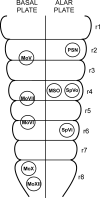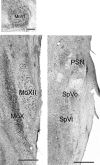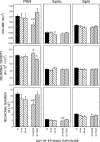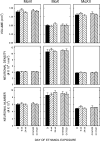Vulnerability of macaque cranial nerve neurons to ethanol is time- and site-dependent
- PMID: 19375881
- PMCID: PMC2706204
- DOI: 10.1016/j.alcohol.2009.03.001
Vulnerability of macaque cranial nerve neurons to ethanol is time- and site-dependent
Abstract
The present study tested the hypotheses that vulnerability to ethanol depends upon (1) population-based characteristics of the neuronal progenitors and (2) the maturation of that population by examining the effects of prenatal exposure to ethanol on brainstem nuclei derived from different rhombomeres and from the alar and basal plates. Macaca nemestrina received an ethanol-containing solution 1 day per week during the first 6 (Et6) or 24 (Et24) weeks of gestation. Control animals received an equivalent volume of saline. The treatment regime for some animals included early gastrulation (gestational day [G] 19 or G20), whereas others were treated later (on G21 or G24). Brainstems were cryosectioned and stained with cresyl violet. Stereological methods were used to determine the numbers of neurons in six different nuclei: the abducens, vagal, and hypoglossal motor nuclei and sensory components of the trigeminal brainstem nuclear complex (the principal, oral, and interpolar subnuclei). There were no differences in the numbers of neurons in any of the nuclei between controls and Et6-, or controls and Et24-treated monkeys. In contrast, the number of trigeminal sensory neurons was significantly (P<.05) lower in animals treated on G19/G20 than in control. No differences between controls and monkeys treated on G21/G24 were detected. No motor nuclei exhibited an ethanol-induced change. These data together with data on the trigeminal motor nucleus show that vulnerability to ethanol (1) is greater in sensory nuclei than in motor nuclei and (2) is temporally restricted to the time of gastrulation.
Figures




Similar articles
-
Time-specific effects of ethanol exposure on cranial nerve nuclei: gastrulation and neuronogenesis.Exp Neurol. 2007 May;205(1):56-63. doi: 10.1016/j.expneurol.2007.01.016. Epub 2007 Jan 24. Exp Neurol. 2007. PMID: 17320867 Free PMC article.
-
Episodic exposure to ethanol during development differentially affects brainstem nuclei in the macaque.J Neurocytol. 2001 Dec;30(12):973-82. doi: 10.1023/a:1021832522701. J Neurocytol. 2001. PMID: 12626879
-
Effect of prenatal exposure to ethanol on glutamate and GABA immunoreactivity in macaque somatosensory and motor cortices: critical timing of exposure.Neuroscience. 2006;138(1):97-107. doi: 10.1016/j.neuroscience.2005.10.060. Epub 2006 Jan 19. Neuroscience. 2006. PMID: 16427209
-
Episodic Prenatal Exposure To Ethanol Affects Postnatal Neurogenesis In The Macaque Dentate Gyrus And Visual Recognition Memory.Int J Dev Neurosci. 2019 Dec;79:65-75. doi: 10.1016/j.ijdevneu.2019.10.005. Epub 2019 Nov 6. Int J Dev Neurosci. 2019. PMID: 31706015
-
Arteether: risks of two-week administration in Macaca mulatta.Am J Trop Med Hyg. 1997 Apr;56(4):390-6. doi: 10.4269/ajtmh.1997.56.390. Am J Trop Med Hyg. 1997. PMID: 9158046
Cited by
-
Acute prenatal exposure to ethanol and social behavior: effects of age, sex, and timing of exposure.Behav Brain Res. 2011 Jan 1;216(1):358-64. doi: 10.1016/j.bbr.2010.08.014. Epub 2010 Aug 20. Behav Brain Res. 2011. PMID: 20728475 Free PMC article.
-
Loss of motoneurons in the ventral compartment of the rat hypoglossal nucleus following early postnatal exposure to alcohol.J Chem Neuroanat. 2013 Sep;52:87-94. doi: 10.1016/j.jchemneu.2013.07.003. Epub 2013 Aug 8. J Chem Neuroanat. 2013. PMID: 23932955 Free PMC article.
-
Fetal alcohol spectrum disorders and neuroimmune changes.Int Rev Neurobiol. 2014;118:41-80. doi: 10.1016/B978-0-12-801284-0.00003-8. Int Rev Neurobiol. 2014. PMID: 25175861 Free PMC article. Review.
-
Dysmorphogenic effects of first trimester-equivalent ethanol exposure in mice: a magnetic resonance microscopy-based study.Alcohol Clin Exp Res. 2014 Jul;38(7):2008-14. doi: 10.1111/acer.12464. Epub 2014 Jun 13. Alcohol Clin Exp Res. 2014. PMID: 24931007 Free PMC article.
References
-
- Altman J, Bayer SA. Development of the brain stem in the rat. II. Thymidine-radiographic study of the time of origin of neurons of the upper medulla, excluding the vestibular and auditory nuclei. J. Comp. Neurol. 1980a;194:37–56. - PubMed
-
- Altman J, Bayer SA. Development of the brain stem in the rat. III. Thymidine-radiographic study of the time of origin of neurons of the vestibular Rand auditory nuclei of the upper medulla. J. Comp. Neurol. 1980b;194:877–904. - PubMed
-
- Ashwell KW, Zhang LL. Forebrain hypoplasia following acute prenatal ethanol exposure: quantitative analysis of effects on specific forebrain nuclei. Pathol. 1996;28:161–166. - PubMed
-
- Astley SJ, Magnuson SI, Omnell LM, Clarren SK. Fetal alcohol syndrome: changes in craniofacial form with age, cognition, and timing of ethanol exposure in the macaque. Teratology. 1999;59:163–172. - PubMed
-
- Byrd KE. Craniofacial sequelae of lesions to facial and trigeminal motor nuclei in growing rats. Am. J. Phys. Anthropol. 1988;76:87–103. - PubMed
Publication types
MeSH terms
Substances
Grants and funding
LinkOut - more resources
Full Text Sources

